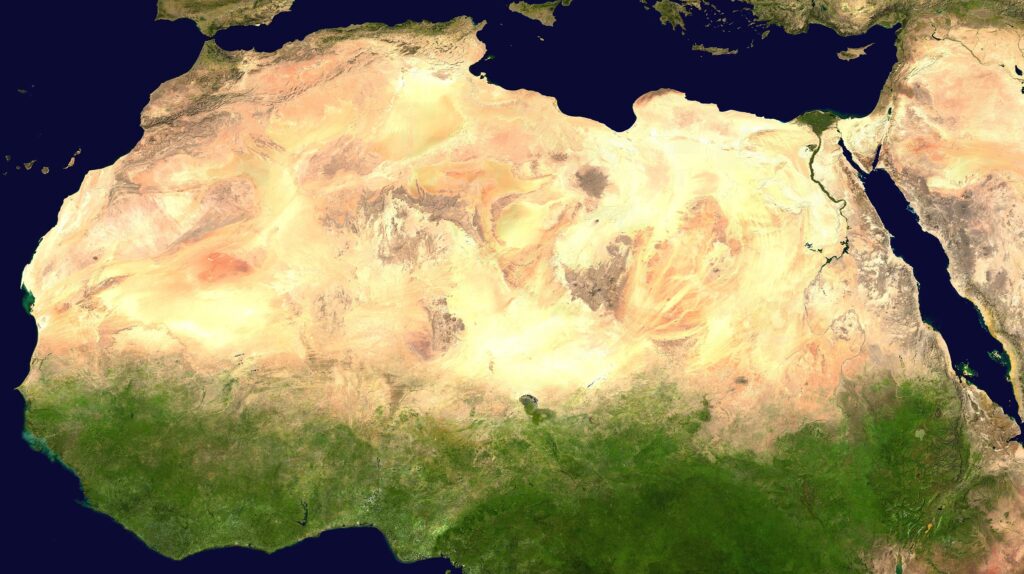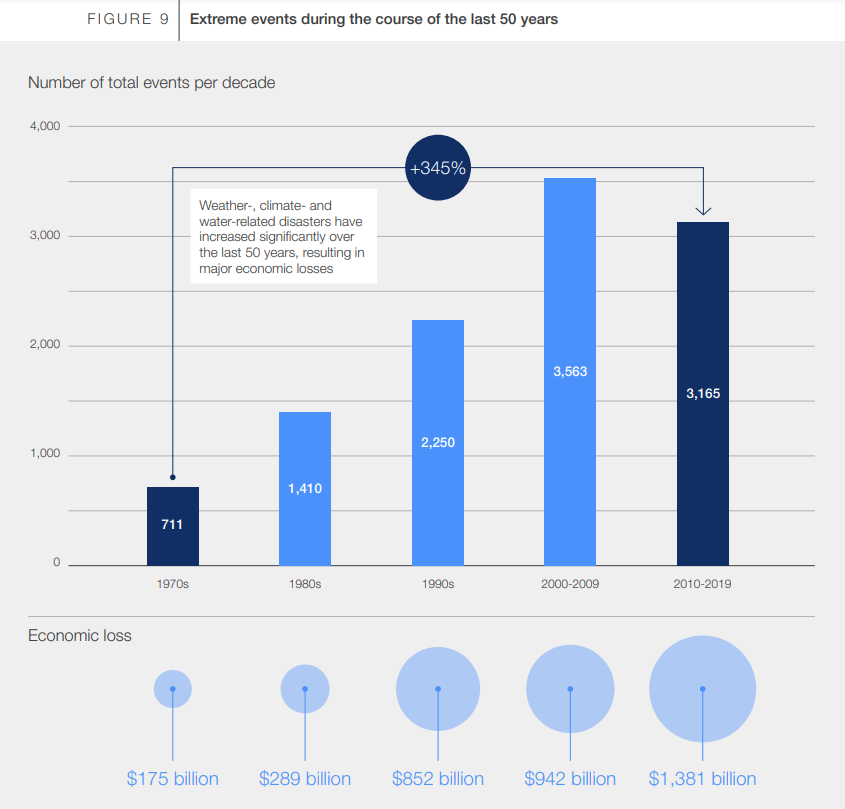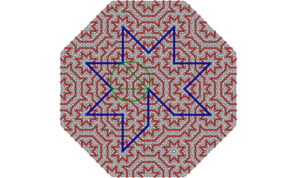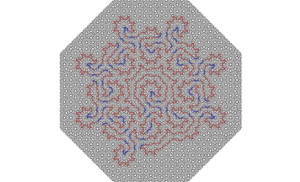
“JASMIN” is a climate research facility in the UK that uses a supercomputer to perform data-intensive analysis of climate data and create climate models. Image: UK Science & Technology Facilities Council.
By Mariana Meneses
Physicists at the University of Bristol have created highly complex mazes inspired by chess moves, designed to potentially revolutionize carbon capture and industrial processes. These mazes are based on quasicrystals, which have ordered but, unlike traditional crystals, irregular atomic arrangements.
Quasicrystal-based mazes could improve processes like carbon capture by providing efficient surfaces for molecules to adhere to, effectively trapping CO2 before it enters the atmosphere. This breakthrough could lead to more effective methods for combating climate change and enhancing industrial efficiency, offering promising solutions for global challenges.
- A complex maze inspired by chess moves. Credit: Singh et al (2024).
- Another example of complex maze inspired by chess moves. Credit: Singh et al (2024).
In other promising news, the University of Oxford has recently reported on a new algorithm developed by Professor Samar Khatiwala that significantly speeds up the preparation of climate models used to predict future climate change. This innovation reduces the time needed to stabilize these models from months to just days, allowing for more detailed and accurate climate predictions. This breakthrough not only saves time and computational resources but also enhances the reliability of climate projections, aiding policymakers in making informed decisions.
Climate modeling involves using advanced computer simulations to predict future climate conditions.
This process requires significant technological power to handle complex calculations and vast amounts of data, for example through the use of a supercomputer at the JASMIN facility in the UK that supports large-scale climate data analysis. By understanding and inputting various variables—such as greenhouse gas concentrations, ocean temperatures, and atmospheric patterns—scientists can create detailed models that help us anticipate climate changes and develop strategies for mitigation and adaptation.
To Professor Colin Jones, Head of the NERC, “The new approaches developed by Professor Khatiwala have the promise to (…) deliver a quantum leap in the efficiency of spinning up such complex models and, as a consequence, greatly increase our ability to deliver timely, robust estimates of global climate change.”
Professor Helene Hewitt, who is part of the team that will inform the next IPCC report, said that “Policymakers rely on climate projections to inform negotiations as the world tries to meet the Paris Agreement. This work is a step towards reducing the time it takes to produce those critical climate projections.”

Sahara desert from space. Image: NASA.
Recently, researchers from the Technical University of Munich and the Potsdam Institute for Climate Impact Research have developed a new method to predict abrupt shifts in Earth’s climate systems, such as the transformation of the once-green Sahara into a desert.
Known as tipping points, these rapid changes are challenging to foresee but crucial for understanding how natural systems can abruptly alter. The study, published in Physical Review X, introduces an advanced early detection method that considers the realistic interconnectedness of climate variables over time, unlike traditional approaches that assume randomness.
Applying their method to the Sahara’s transition, the scientists detected early warnings of vegetation loss, indicating a destabilization leading to desertification. This breakthrough could enhance our ability to anticipate and respond to future climate tipping points, potentially mitigating their damage to ecosystems and societies affected by climate change.

Virtual reality can assist decision-makers to experience the effects of climate change. Image generated using Ideogram AI.
Technology also plays a crucial role in making the climate crisis more relatable, undeniable, and actionable, according to the World Economic Forum (WEF). By using immersive technologies like virtual reality (VR) and augmented reality (AR), decision-makers can experience the effects of climate change firsthand, bridging the gap between abstract data and tangible consequences.
For instance, simulations in the WEF’s Polar Tipping Points Hub visualize critical ecological shifts, such as Arctic ice melt and permafrost thaw, illustrating how these phenomena amplify global warming and trigger irreversible climate tipping points. Introduced in 2023, the Polar Tipping Points Hub allows collaborators to share information and ideas while monitoring conditions in the arctic, where five of the sixteen global climate tipping points are located.
Data-driven and digital technologies are crucial in addressing the escalating damages of climate change, complementing efforts to mitigate greenhouse gas emissions.
As the world grapples with acute and chronic climate hazards, these technologies offer unique capabilities across the adaptation cycle.
These include tracking risks through satellite, drone, and Internet of Things (IoT) data coupled with AI for enhanced prediction systems. This provides an early warning system and informed supply chain management and allows for dynamic crisis responses with AI and drones for post-crisis mapping and resource allocation.
However, to unlock their full potential, these technologies must become more standardized, transparent, and accessible, particularly in underserved regions.
Initiatives like open-source data sharing, improved interoperability, increased funding for adaptation technology, and regulatory frameworks focused on climate adaptation are crucial steps outlined by the World Economic Forum and its partners to foster collaboration and accelerate the adoption of climate-resilient technologies worldwide.
The World Economic Forum’s 2024 report Innovation and Adaptation in the Climate Crisis: Technology for the New Normal underscores several pivotal technologies essential for climate change adaptation, particularly in conjunction with artificial intelligence (AI). AI serves as a cornerstone in adaptive strategies, facilitating predictive decision-making, real-time process optimization, and enhanced understanding of climate risks and opportunities.
Complementing AI, IoT technologies enhance data collection, improve planning and decision-making, and streamline processes in real-time.
IoT refers to a network of interconnected devices that communicate and exchange data, for instance smart sensors in farm fields that monitor soil moisture and weather conditions, promoting sustainable agricultural practices and conserving valuable resources.
“The impacts of climate change are intensifying. If present trends continue, extreme weather events could increase to 560 per year – 1.5 per day – by 2030. Meanwhile, slow-onset events like drought and sea-level rise are worsening. People, nature, and businesses are vulnerable. Leaders have no choice but to adapt.” – World Economic Forum
Recent research on global wildfire trends reveals that while overall burned area on Earth may be decreasing, climate change is intensifying wildfire behavior, particularly in regions such as the boreal and temperate conifer biomes which are forested zones like those in the northern and temperate areas. By analyzing 21 years of satellite data and focusing on extreme wildfire events, the study finds a significant 2.2-fold increase in the frequency of these extreme events from 2003 to 2023.
The last seven years notably include the most extreme events observed.
This worsening trend has profound implications for human vulnerability to wildfire disasters, underscoring the pressing need for adaptive strategies.

Image: World Economic Forum.
A recent study published in Nature Climate Change and led by Brittany Trew, from the University of Exeter, examined how climate change affects tropical forest biodiversity, focusing on conditions beneath the canopy.
“In biology, the canopy is the aboveground portion of a plant cropping or crop, formed by the collection of individual plant crowns. In forest ecology, canopy refers to the upper layer or habitat zone, formed by mature tree crowns and including other biological organisms” (Wikipedia).
Conducted globally from 1990 to 2019, the study modeled hourly below-canopy climate data across 300,000 locations.
Findings show that even slight temperature increases under 1°C have significantly altered temperature regimes across most tropical forests, challenging the belief that canopies buffer extreme temperatures. This sensitivity underscores the vulnerability of tropical forests to climate change, despite contiguous forest cover in continuous, unbroken expanses of forested land where the trees are closely packed together without significant gaps.
It is worth noting that the study identified some global forest areas as climate refuges, maintaining stable temperatures and highlighting their crucial role in biodiversity conservation efforts. These findings prompt urgent calls for protection and restoration of these refuges amidst increasing climate variability.

“The Andaman Islands [in India] have a tropical rainforest canopy, made of a mixed flora with elements from Indian, Myanmar, Malaysian and endemic floral strains”. Credit: Vyacheslav Argenberg.
A recent study on Amazonian tropical forests highlights their critical role as carbon sinks but identifies alarming trends of declining carbon absorption due to deforestation and droughts exacerbated by climate change. The study integrates remote sensing of photosynthetic activity with ground-based measurements of tree demographics to understand how different forest ecotopes respond to drought.
“Ecotopes are the smallest ecologically distinct landscape features in a landscape mapping and classification system. As such, they represent relatively homogeneous, spatially explicit landscape functional units that are useful for stratifying landscapes into ecologically distinct features for the measurement and mapping of landscape structure, function and change.” (Wikipedia)
Remote sensing of photosynthetic activity involves using satellite or aerial sensors to monitor the health and growth of plants from a distance. These sensors detect light reflected by plants, particularly in the red and near-infrared wavelengths, to measure how much photosynthesis is occurring. This technology helps scientists track vegetation health, agricultural productivity, and changes in ecosystems over time.
In southern Amazonia, forests with shallow water tables show resilience through enhanced photosynthetic activity in response to excess sunlight, but become vulnerable to browning and tree mortality as drought persists. Conversely, northern Amazonia’s forests, characterized by lower fertility but hardier tree species or deep-rooted access to water, exhibit more resilience to drought regardless of water-table depth.
This biogeographical insight into drought response underscores the complex interplay between ecological factors and climate impacts, informing conservation strategies and predicting how diverse Amazonian forests may fare under future climate scenarios.
Another study investigates how anthropogenic habitat destruction reduces biodiversity through habitat loss and fragmentation. It distinguishes between these two processes: habitat loss refers to the overall reduction in habitat area, while habitat fragmentation involves the division of remaining habitat into smaller, isolated patches. The study reveals that while habitat loss universally harms biodiversity, the effects of fragmentation depend on the extent of habitat loss.
The study demonstrates that moderate levels of habitat loss combined with fragmentation can enhance species coexistence by reducing competitive dominance. In contrast, extensive habitat loss with fragmentation tends to isolate smaller patches, leading to increased competition and species extinctions.
Over the past years, we have witnessed unprecedented extreme weather events globally.
Patterns like these underscore the vulnerability of forests to climate change, even in areas with continuous forest cover. The resilience of diverse forests under future climate scenarios remains uncertain. And, while habitat loss universally threatens biodiversity, the impact of fragmentation varies depending on the scale and extent of such loss.
Amid increasing measures to reduce greenhouse gases, information and communication technologies (ICTs) emerge as pivotal tools for monitoring and mitigating industrial atmospheric emissions linked to climate change. Key ICT tools include the Internet of Things for energy consumption management, data analytics for informed decision-making on emissions and energy use, and remote sensing technologies for monitoring land use changes and carbon sequestration efforts.
Scientists are using advanced technologies and innovative methods to address urgent climate challenges, from creating chess-inspired mazes for carbon capture to developing faster climate modeling algorithms.
These advancements offer more effective strategies for combating climate change and improving our ability to predict and mitigate abrupt environmental shifts, such as the Sahara desert’s transformation. As technology evolves, its role in monitoring, understanding, and adapting to climate change grows increasingly crucial.
Craving more information? Check out these recommended TQR articles:
- Race for Post-Quantum Cryptography: Will Proposed Encryption Standards Secure the World’s Data?
- What Will a Recent Quantum Leap in Time Crystal Technology Reveal About the Elusive Nature of Time?
- Adaptive Intelligence: The Power of Genetic Mutations and Neural Networks
- Citizen Action Combines With Innovative New Methods to Combat Cybersecurity Threats
- The Incredible Power of Shape: Fractals Connect Quantum Computers to the Human Body and the Cosmos





